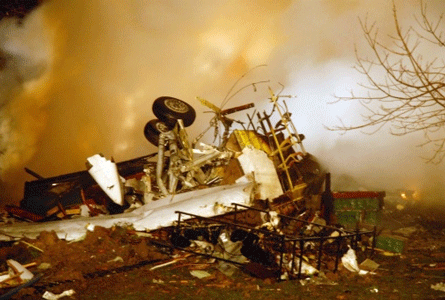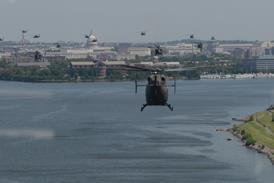Pratt & Whitney Canada has gone back to basics to ensure success for its PW500 turbofan family
Guy Norris/MONTREAL

Every engine has a theme - "and for the PW545 it is simplicity," says PW500 series senior programme manager Maurice Weinberg. "We built it as simply as possible and there is nothing fancy in it - no IGVs [inlet guide vanes], or anything like that."
Simplicity suited Pratt & Whitney Canada's design goals for the PW545A, the largest of its three-member PW500 family. They were as basic as the engine itself - rugged, low cost, good performance and high reliability. The new family had a lot to live up to as heir apparent to the popular JT15D generation, the bridge to P&WC's more powerful PW300 family and the choice for Cessna's new Citation business jets.
"The JT15D has been an excellent engine for the company. It has ridden through all the dips really well and we are still building them, but we wanted to make sure we could replace it with another P&WC engine," says Weinberg. Through the early 1990s, the company evaluated its options and the marketplace and, in April 1993, began designing the first family member, the PW530A. "We said 'let's do a 1990s version of the JT15D', but at the same time, we thought we'd expand the power range to get us into a bigger market, and bridge the gap to the PW300."

The approach has been rewarded with the development of what amounts to a symbiotic relationship between the PW500 and Cessna. The PW530A entered service with the Citation Bravo in 1996, the PW545A with the Citation Excel in 1997, and the Citation Encore Ultra powered by the PW535A, was certificated in April 2000.
All were targeted by the PW500 design philosophy, which was aimed squarely at the newest models emerging in the light to medium corporate aircraft market. The family was mapped to cover the 2,700-4,500lb-thrust (12-20kN) range and was developed around a 4:1 bypass ratio which contributed significantly towards a target fuel consumption reduction of 13-15% over the JT15D. "Fuel burn reduction was important not so much for increasing range, but for the 'domino' effect" on aircraft size and weight," says Weinberg.
A cornerstone of the PW500 family philosophy is the common core around which all three engines are based and the simpler overall design. "That's the real heart of what we wanted to do, which was to minimise the mechanical complexity, yet at the same time go with 1990s technology. We also wanted reduced vibration levels, particularly as we are on a corporate jet which desires big comfort. Cessna particularly likes comfort and, compared with the JT15D, this reduces vibration levels in the cabin by an order of magnitude," he adds.
The three family members' cores are virtually identical. Every PW500, no matter what its application, has two axial stages, a reverse flow combustor and a centrifugal impeller at its heart. Faced with a chance to move away from a centrifugal-based concept, P&WC had no hesitation in sticking with what it knew best.
Centrifugal advantages
"A centrifugal design gives you a lot of advantages at this power level. We would have had a lot of axial stages that would be very small, and sensitive to tip clearance," says Weinberg. "That would also have cost us a lot of money to keep them tight." The decision also tied in closely to the programme's cost-saving goals in other ways. Centrifugal designs use fewer parts and fewer parts mean lower costs. "Cost is a direct function of the number of parts," he says.
The reverse flow combustor, another feature unique to centrifugal designs, was also a preferred solution. "The thermal profiles are very good and so is stability because the hot gases have to turn the corner," adds Weinberg who says the durability of the high-pressure turbine (HPT) is also increased because it is physically isolated from the radiation energy emitted by the heat of the combustor reaction.
Despite this relative protection, the increased operating temperatures of the PW545 persuaded P&WC to substitute the existing HPT blades - made from a directionally solidified, super alloy material - with a single-crystal, MAR M 247 nickel-based alloy. A total of 16 vanes, cast in a one-piece ring from the same alloy, make up the HPT stator stage, while the HPT itself consists of 70 individual blades.
Further upstream in the core, titanium is extensively used for the compressor rotors, stators and a one-piece impeller which is cast with 26 "blades". The two-stage rotor and stator in the high-pressure compressor is conventional in design, but is noteworthy for how the 29 stators making up the last stage are cantilevered, and are attached only to the compressor casing's outer diameter. Compressed air is pumped by the impeller into a single, annular combustor via 22 individual "fishtail" diffuser pipes.

The largest changes between the family members are outside the core. The PW530, for example, has a two-stage low pressure turbine driving a 58.4cm (23in) diameter fan, while the larger PW545 has a three-stage low-pressure turbine (LPT) to drive the larger 68.8cm fan and an additional low-pressure compressor rotor. The first LPT stator stage has 51 vanes made of MAR M 247, while the remaining rotors and stator stages are made of Inconel alloys. Largest counts occur in the third LPT stages where the stator and rotor have 65 and 64 vanes and blades respectively. Exhaust gases leave the LPT and exit via a 12-lobe mixer shaped "more for performance than noise", says Weinberg, who adds that despite this, "we did gain some noise benefit as well". The mixer is made from a nickel-based Inconel 625 alloy.
The LPT drives the 19-bladed, wide-chord front fan and a single-stage, 55-integrally bladed low-pressure (LP) compressor rotor. Both are made from titanium, while the stators either side of the LP compressor stage are fabricated from stainless steel. A set of 60 large stators is also located in the fan bypass duct, immediately adjacent to the LPC rotor, and are made from aluminium.
Key controls
Another key differentiator from the other PW500 members is the fully functioning electronic engine control (EEC) system, added to the PW545 to supersede a custom-made hydromechanical control developed for the earlier engine. The single-channel EEC adds a new level of redundancy for Excel operators who can dispatch with either system inoperative.
A new control system logic has been added to avoid the "thrust bump" possible when the engine defaults from one control system to another. This happens because the EEC is an N1 (LP spool) controller, while the hydromechanical system is an N2 (HP spool) controller. "You can get a 20-30% thrust bump - up or down," says Weinberg. "But our controller knows where the N2 rating is, and the minute it goes into reversionary mode, it locks into that and sets its schedule to that thrust so you get no bump."
The EEC provides fuel flow and bleed valve supervisory control, as well as thrust reverser logic for various engine power settings and synchronisation between N1 and N2 speeds. The controllers also contain a governor to guard against N2 underspeeds, and protects against N1 and N2 redline speed exceedences.
The EEC is typical of the extra attention to tight control lavished on the engine by P&WC. The suite of controllers also includes a fuel control unit with an integral fuel pump, a flow divider valve, data collection unit, engine sensors and a P2.8 bleed off valve. This essentially bleeds air upstream of the impeller and, based on a pneumatic schedule that changes the incidence angle of the HPC stages, guards against a potential surge condition during start-up and taxiing. "It is just there to skirt around the bucket," adds Weinberg.
Since entering service in late 1998, the engine has amassed almost 31,000 operational hours and has had zero in-flight shut downs or unscheduled removals. Encouraged by its robustness, P&WC has begun high-altitude tests of the PW545 with NASA for potential unmanned air vehicle applications in the future.
Finding new applications is only the beginning, says Weinberg: "We're looking at ways to grow the engine and do other things with it, because we think it's the greatest thing since sliced cheese."
Source: Flight International























